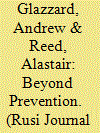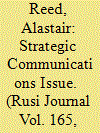| Srl | Item |
| 1 |
ID:
171669


|
|
|
|
|
| Summary/Abstract |
The rise to prominence of Daesh and its expert exploitation of extremist propaganda has brought in to focus the role of strategic communications in counterterrorism (CT) and countering violent extremism policy. Nonetheless, strategic communications tends to be discussed largely in relation to counter-recruitment and counter-radicalisation. Using the UK’s CT strategy as a case study, Andrew Glazzard and Alastair Reed argue that strategic communications has a far wider application in CT.
|
|
|
|
|
|
|
|
|
|
|
|
|
|
|
|
| 2 |
ID:
171662


|
|
|
|
|
| Summary/Abstract |
The weaponisation of communications by state and non-actors has emerged as one of the most pressing security concerns facing Western democracies. Over the past decade, the communication threat from extremist organisations has been transformed by the rise of the Islamic State (IS). While the use of propaganda is nothing new, IS has employed strategic communications more successfully than earlier extremist organisations, and effectively exploited the emergence of new technologies to disseminate its message directly. But the reach of this new approach to communication goes far beyond IS, with the threat from other extremist movements such as far-right and nationalist groups becoming increasingly challenging. This step-change is, of course, not limited to non-state actors. States have also sought to exploit the influencing power of new technology to conduct disinformation campaigns, such as Russian interference in the US elections. Thus, liberal democracies face multiple threats from malign influencing activities, and the nature and perceptions of these threats have been transformed by the emergence of new technology, in particular social media. As a result, strategic communications needs to become an increasing priority, and while the threats are diverse, they do not exist in isolation, and our response needs to be both strategic and comprehensive.
|
|
|
|
|
|
|
|
|
|
|
|
|
|
|
|